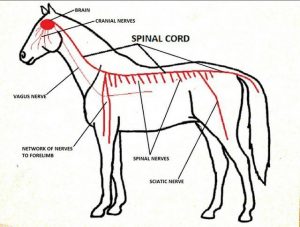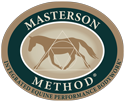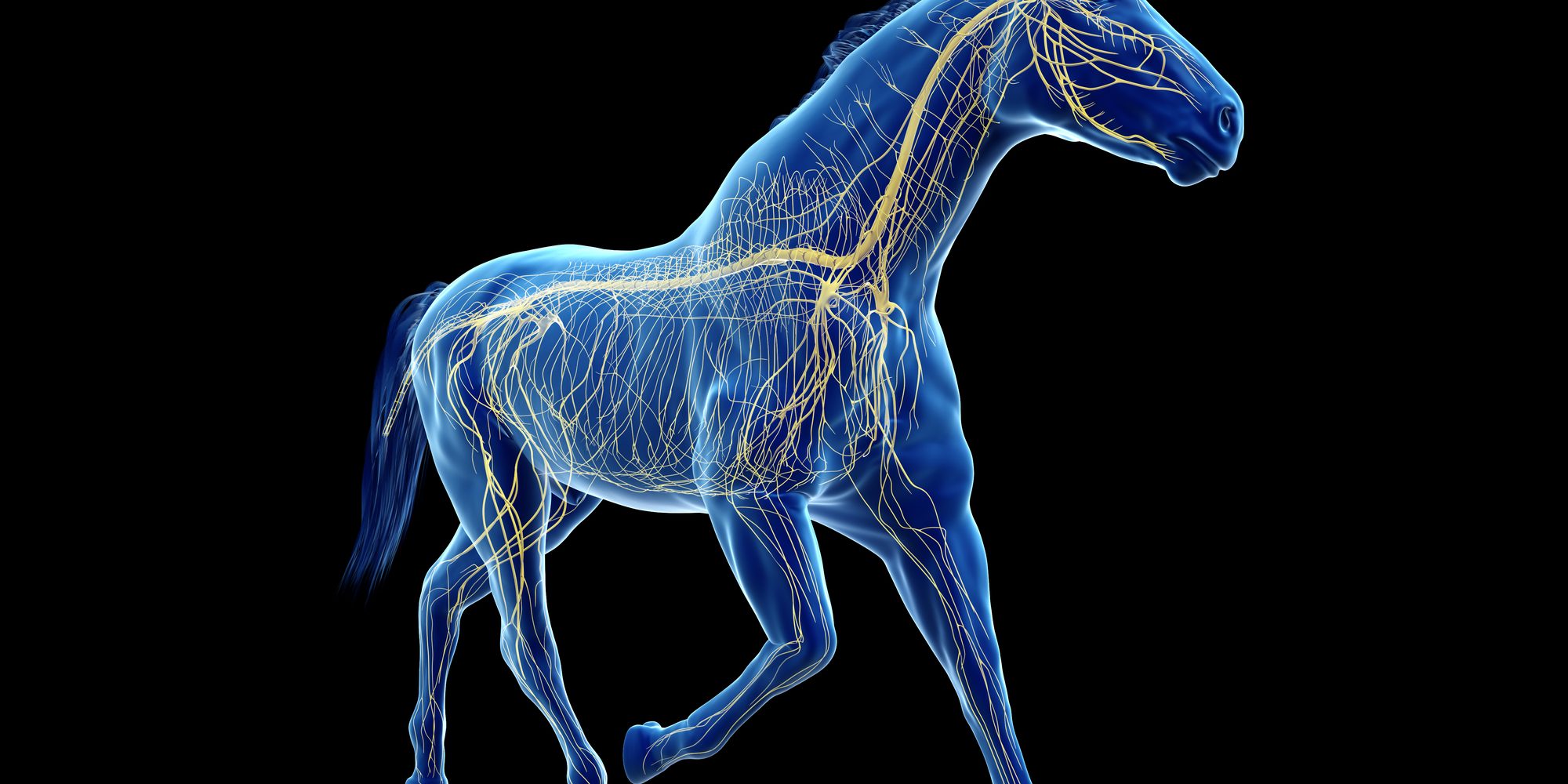by Megan Dushin MMCP, MMES
If you’ve seen Jim Masterson or a certified practitioner demonstrate The Masterson Method®, then you’ve seen what some common “releases” look like when a horse lets go of tension. A horse may lick and chew, shake his head, scratch himself, sigh or snort, rest a hind leg, yawn profusely, or otherwise look like he’s released tension. At first it may seem like magic, but here’s how Jim explains this phenomenon:
“Horses survive by blocking out pain and discomfort. If they show lameness at the first sign of discomfort, their survival is threatened. We’ve learned from experience that if you work beneath their natural blocking/survival response, you can access that part of the nervous system that releases rather than holds on to tension. The horse will “tell” you when it has released tension with visible changes in behavior such as licking and chewing, sighing, snorting or sneezing, and yawning.”
When I first experienced this work and started looking into it, I was excited to learn that these are signs that the horse’s parasympathetic autonomic nervous system is activated. That’s a mouthful, right? It basically means they’re chill. When we use light touch and/or movement while staying “beneath their natural blocking/survival response” we help them become aware of and release tension without being threatened by our presence. Scientifically it is believed that these releases – licking and chewing, yawning, etc. – are signs that the horse is shifting from a state of stress (sympathetic, sometimes called fight/flight) to a state of relaxation (parasympathetic, sometimes called rest and digest).
 One book I came across recently included some interesting exercises to induce your own relaxation response – that’s right, self-help to trigger the autonomic nervous system. The book is titled Accessing the Healing Power of the Vagus Nerve: Self-Help Exercises for Anxiety, Depression, Trauma, and Autism (published by North Atlantic Books, Berkeley, CA; 2017). The title alone was intriguing to me. The author, Dr. Stanley Rosenberg, shares exercises based on his decades of experience as a body therapist (craniosacral, osteopathic manipulation, Rolfing, and other modalities) and on research on the role of the vagus nerve and other cranial nerves in creating psychosocial well-being. I was interested in the linkages between body therapy constructs for people and the work we do in The Masterson Method®.
One book I came across recently included some interesting exercises to induce your own relaxation response – that’s right, self-help to trigger the autonomic nervous system. The book is titled Accessing the Healing Power of the Vagus Nerve: Self-Help Exercises for Anxiety, Depression, Trauma, and Autism (published by North Atlantic Books, Berkeley, CA; 2017). The title alone was intriguing to me. The author, Dr. Stanley Rosenberg, shares exercises based on his decades of experience as a body therapist (craniosacral, osteopathic manipulation, Rolfing, and other modalities) and on research on the role of the vagus nerve and other cranial nerves in creating psychosocial well-being. I was interested in the linkages between body therapy constructs for people and the work we do in The Masterson Method®.
I read a passage that explained how to do an exercise to trigger your body to swallow, sigh, or yawn and said to myself, “Wait a minute! That’s what we’re doing with horses!” We’re using specific, light touch and/or movements in a relaxed state to trigger a release such as a lick and chew, sigh, yawn, head shake, etc. So, I thought I’d share an excerpt of the book explaining the exercise in case you want to see if it makes you release (pp. 186-190):
“Lying comfortably on your back, weave the fingers of one hand together with the fingers of the other hand.Put your hands behind the back of your head, with the weight of your head resting comfortably on your interwoven fingers. You should feel the hardness of your cranium with your fingers, and you should feel the bones of your fingers on the back of your head….Keeping your head in place, look to the right, moving only your eyes, as far as you comfortably can. Do not turn your head; just move your eyes. Keep looking to the right.After a short period of time—up to thirty or even sixty seconds—you will swallow, yawn, or sigh. This is a sign of relaxation in your autonomic nervous system….Bring your eyes back to looking straight ahead.Leave your hands in place, and keep your head still. This time, move your eyes to the left.Hold your eyes there until you notice a sigh, a yawn, or a swallow.”
If you’re not able to lie on the floor at this moment, you could try the exercise while sitting in a chair or standing, however be sure your back posture is upright and head and neck are in (vertical) alignment and relaxed (he suggests to try it on the floor for the first few times, probably to ensure that you can feel the relaxation of your cranium onto your hands). When I did it, I was amazed at the results: I sighed on both sides about 40 seconds in. The exercise gave me a felt sense of shifting to a more relaxed state and provided a sense of what we’re asking of horses.
 In addition to this and other self-help exercises outlined in the book, I was intrigued by the author’s perspective on the autonomic nervous system. Drawing from the research of Dr. Stephen Porges, a neuroscientist who developed the Polyvagal Theory, Rosenberg claims that the vagus nerve (cranial nerve X, also called the wandering nerve because it innervates so many organs of the body) and several other cranial nerves – when functioning properly – can help us become more socially engaged. Another concept in the Polyvagal Theory is that there is a correlation between a person who is shutdown or depressed (the freeze part of the autonomic fight/flight/freeze response) and the activation of the back or dorsal side of the vagus nerve.
In addition to this and other self-help exercises outlined in the book, I was intrigued by the author’s perspective on the autonomic nervous system. Drawing from the research of Dr. Stephen Porges, a neuroscientist who developed the Polyvagal Theory, Rosenberg claims that the vagus nerve (cranial nerve X, also called the wandering nerve because it innervates so many organs of the body) and several other cranial nerves – when functioning properly – can help us become more socially engaged. Another concept in the Polyvagal Theory is that there is a correlation between a person who is shutdown or depressed (the freeze part of the autonomic fight/flight/freeze response) and the activation of the back or dorsal side of the vagus nerve.
The concepts that a) social engagement is an important factor in psychological well-being, b) the nervous system plays a role in facilitating prosocial behaviors, and c) we can impact our nervous system with exercises and bodywork, were novel to me. Although the Polyvagal Theory is far more complex and parts of it are still contested by some researchers today, Rosenberg is convinced that exercises such as the one above, along with bodywork can help improve social engagement and overall psychosocial well-being.
If that is the case, then it begs the question: is the work we’re doing in The Masterson Method® also improving a horse’s social engagement? If so, with whom? With the person who’s doing the bodywork (we experience improved communication with horses)? With other horses in their herd?
I posed the question to the Facebook group of fieldwork students and practitioners to see if they’ve noticed any social benefits among horses they work with. Here are several comments:
“Just last week I had a new client offer feedback that her horse was more social with his field mate post session. It was an aspect I’d never considered.”
“Some clients want me to work with their horses specifically for the psychological/social benefits.”
“Yes, I have experienced the shutdown horse [being] more socially engaged after bodywork. I also often witness some horses during body work show interest in their immediate surrounding, like they “see” things that have been there always, for the first time, the need to sniff it, touch it!”
If you haven’t yet tried The Masterson Method® on your horse, try out the Bladder Meridian Technique, the most basic technique to learn how to read the horse’s nervous system and establish a connection. Here’s a YouTube video on how to do the Bladder Meridian Technique.
And then I invite you to consider if and how The Masterson Method sessions might impact your horse(s) social behavior. Does he relate to you differently? Other people? How about to other horses? I also invite you to try out the exercise excerpted from the book, especially if you need or want to be in a relaxed state (for a bodywork session perhaps)! Who knows? It may help!
Learn more about The Masterson Method® by ordering a copy of the Beyond Horse Massage Book.
Get hands-on training at a Beyond Horse Massage Weekend Seminar near you.













